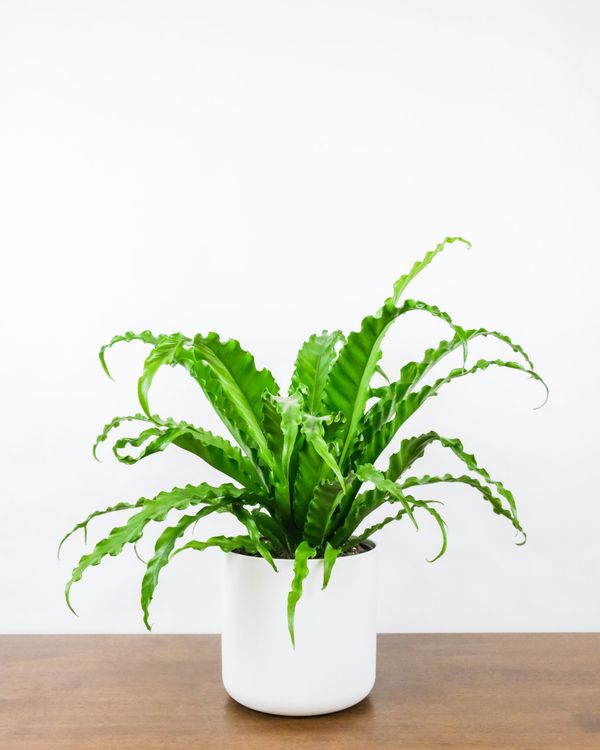Bird's Nest Fern Care Guide
How to grow and care for Bird's Nest Fern (Asplenium nidus)
The Asplenium nidus, commonly known as the Bird's Nest Fern, is a popular indoor plant cherished for its lush, curly fronds that emerge in a nested formation. Originating from the tropical and subtropical regions of Asia, Australia, and the Pacific Islands, this striking plant adds a touch of exotic beauty to any indoor space. Known for its hardy nature and relatively low-maintenance care, the Bird's Nest Fern is an excellent choice for both novice and experienced plant enthusiasts.

Disclosure: This content includes affiliate links, which means we may earn a commission if you click on a link and make a purchase. As an Amazon Associate, we earn from qualifying purchases. This comes at no extra cost to you and helps offset the cost of running Leafwise. Please read our disclaimer for more info.
Table of Contents
Care
Light
Bird's Nest Ferns thrive in low to medium indirect light. Avoid direct sunlight, which can scorch the leaves. An east- or north-facing window is ideal, or place the plant in a well-lit room away from intense rays.
Watering
Keep the soil consistently moist but never soggy. Water when the top inch of soil feels dry to the touch. During the growing season (spring and summer), you may need to water more frequently. Avoid watering directly into the central rosette—the leafy center of the plant—to prevent mold and rot. Instead, water the soil around the base.
Humidity
As tropical plants, Bird's Nest Ferns love high humidity. Aim to maintain at least 50–60% humidity. In addition to misting, placing the plant in a naturally humid room like a bathroom or using a humidifier is highly effective. You can also set the pot on a pebble tray filled with water to boost humidity around the plant.
Temperature
These ferns prefer temperatures between 60–75°F (15–24°C) and are sensitive to drafts or cold air. Avoid exposing them to temperatures below 50°F (10°C).
Soil
Use a well-draining, peat-based potting mix that retains some moisture without becoming waterlogged. A mix designed for ferns or aroid plants—such as those used for philodendrons or pothos—is ideal. Consider adding amendments like vermiculite, coarse sand, or horticultural charcoal to improve aeration and moisture regulation.
Maintenance
Fertilizing
Feed every 4–6 weeks during the growing season with a balanced, water-soluble fertilizer diluted to half strength. Apply fertilizer directly to the soil, avoiding contact with the fronds or the plant's center rosette, which is especially sensitive. Avoid fertilizing during the fall and winter when growth naturally slows.
Pruning
Remove yellowing or dead fronds at the base to maintain the plant's appearance and promote healthy growth. Avoid trimming healthy fronds or cutting into the central rosette, as this can permanently damage the plant.
Propagation
Propagating Bird's Nest Ferns is more advanced than with many houseplants because they do not produce offsets or viable stem cuttings. Instead, they reproduce via spores:
- Wait until fertile fronds develop dark brown spores on the undersides.
- Cut off these fronds and place them in a paper bag until the spores are released.
- Sprinkle the spores onto a moist, sterile medium such as peat moss.
- Cover with plastic or a dome to maintain humidity and place in indirect light.
- Keep the medium consistently moist and warm. Germination may take 4–8 weeks or longer, so patience is key.
Common Issues
Bacterial Blight
- Cause: High humidity combined with poor air circulation can lead to bacterial or fungal infections.
- Symptoms: Small water-soaked spots on fronds that turn purple and spread along the veins.
- Solution: Remove and dispose of affected fronds immediately. Improve air circulation and avoid overhead watering. If necessary, apply a copper-based fungicide according to label instructions.
Pests
- Cause: Dry indoor conditions, poor airflow, or dusty leaves can lead to infestations by spider mites or scale insects.
- Symptoms: Speckled or yellowing leaves, sticky residue (honeydew), or small brown bumps on stems and undersides of fronds.
- Solution: Wipe the leaves with a damp cloth and treat affected areas with insecticidal soap or neem oil. Repeat weekly as needed until pests are eliminated.
Root Rot
- Cause: Overwatering or poorly draining soil causes excess moisture at the roots, promoting fungal growth.
- Symptoms: Mushy roots, yellowing or wilting fronds, and a foul odor from the soil.
- Solution: Remove the plant from its pot, trim off affected roots, and repot in fresh, well-draining soil. Ensure the new pot has adequate drainage holes.
Yellowing Leaves
- Cause: Overwatering, low humidity, or nutrient deficiencies.
- Symptoms: Lower fronds gradually yellow, sometimes with a soft or drooping texture.
- Solution: Improve humidity, adjust watering frequency, and apply a balanced, diluted fertilizer during the growing season. Also, assess your care routine and make necessary adjustments—enhance airflow, maintain stable humidity, and avoid overwatering.
With the right care, your Bird's Nest Fern will reward you with elegant, wavy foliage and a lush, tropical presence in your indoor space year-round.
